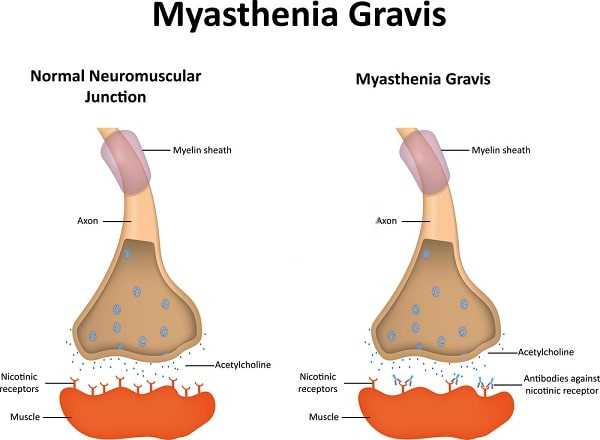How Myasthenia Can Affect You Over Your Lifetime

As with other autoimmune diseases, there’s a lack of research into how MG affects women at different times of their lives. Most of the information we have is anecdotal, gleaned from the experience of neurologists who treat women with myasthenia.
Janice M. Massey, MD, professor of neurology and director of the Myasthenia Gravis Clinic at Duke University Medical Center.

Premenstrual Fluctuations
Many women with MG report that their symptoms get worse during the premenstrual period. According to the Myasthenia Gravis Foundation of America, it’s believed that progesterone is responsible for the worsening of muscle weakness during this period (especially since symptoms improve once a period begins and progesterone drops off). However, it may be difficult to distinguish between possible hormonal effects, the effects of premenstrual syndrome, and a true exacerbation of symptoms.
“A small percentage of women report a worsening of myasthenia premen-strually. It’s something that the literature has repeated over the years, but it’s never been studied, to my knowledge,” remarks Dr. Massey. “It really is unclear whether there’s a worsening of symptoms or that women with premenstrual syndrome generally feel worse during that time, especially in terms of fatigue or stress, and that affects their myasthenia.”
For example, fatigue is usually a product of muscle weakness rather than a symptom of the disease itself (as it is in RA or lupus), she notes. If PMS brings increased irritability and stress, that may worsen muscle weakness and fatigue. Women with myasthenia have to pace themselves and need to make extra accommodations during the premenstrual period, says Dr. Massey. Discomfort from symptoms that are clearly PMS related, such as bloating, breast tenderness, irritability, and mood swings, needs to be dealt with separately and in consultation with a gynecologist.
Pregnancy
Myasthenia itself doesn’t affect your ability to become pregnant, and generally doesn’t affect the normal growth and development of a fetus. (In rare cases, arthrogryposis, a congenital abnormality causing limb contractures, is seen in infants of MG mothers.) There is a risk of the disease worsening and of the baby developing a temporary neonatal myasthenia. MG can even be triggered by pregnancy.

“Some women initially present during the first trimester or immediately after delivery. The progression of symptoms can be fairly dramatic over a period of days or weeks. The immune system is markedly altered in pregnancy to allow a woman to carry a fetus, and that is partly hormonally driven,” observes Dr. Massey.
For women with myasthenia, prepregnancy counseling is extremely important. “We have no way of predicting how a particular woman will do during pregnancy. If we need to continue treatment, there are safety factors to consider. Women also need to know that they’ll need more rest than usual to avoid symptom exacerbations,” says Dr. Massey. “The course of myasthenia can be unpredictable during pregnancy. In general, it may worsen early in the pregnancy or right after delivery. However, after that exacerbation, the disease may stabilize again, as it does in MS.” There’s no way to predict which women will worsen after pregnancy, she adds.
Cholinesterase inhibitors like Mestinon have not been shown to cause birth defects, but some muscle weakness has been reported in newborns whose mothers took the drugs. They cannot be given intravenously, since it can lead to premature labor. Prednisone carries minimal risks to the fetus and is used during pregnancy. If you experience an exacerbation of MG during pregnancy, you can be admitted to the hospital, where you can undergo plasmapheresis and the baby can be monitored.
Late in pregnancy, the growing fetus can restrict the movement of the diaphragm, causing some shortness of breath. The drug magnesium sulfate, given to control eclampsia (high blood pressure in pregnancy), exacerbates MG, so other medications must be used to control blood pressure. In rare instances, a ventilator for respiratory support may be needed, says Dr. Massey.
While labor can be extra exhausting when you have MG, the disease doesn’t affect the onset and duration of labor, since the uterus is smooth muscle. However, the voluntary and skeletal muscles can become weakened if labor is prolonged, and you can become extremely exhausted. Pain relief medication is given on an individualized basis. Muscle relaxants used during labor anesthesia may temporarily exacerbate muscle weakness. As in women without MG, cesareans are done when indicated.
“Women with myasthenia need to be followed in a high-risk obstetrical facility, in conjunction with a neurologist, and there has to be close communication by the care team,” stresses Dr. Massey. “We usually admit women for the last week or two prior to delivery, so they and their baby can be closely followed.”
Breastfeeding
There’s no reason to avoid breastfeeding, but you may find it extremely fatiguing. While antimyasthenics have not been reported to cause problems in nursing babies, Mytelase has not been rated for safety during lactation. The Physicians’ Desk Reference (PDR) advises caution with Prostigmin, since risk cannot be ruled out. Mestinon is excreted in breast milk, but since no effects have been reported in infants it can be used (however, newborns should be monitored). Steroids are excreted in low levels, and the risk to the baby is considered low, adds Dr. Massey. Azathioprine, cyclosporine, and cyclophosphamide pass into breast milk and are not used in breastfeeding women.
AChR antibodies not only cross the placenta but can be found in low levels in breast milk, discouraging many women from breastfeeding. “Getting up during the night to breastfeed may completely wear a woman out. It’s difficult to deal with caring for a newborn and a chronic disease. Most of my patients opt not to breastfeed so that someone else can feed the baby at night, and because they are worried about medications and the antibody issue,” says Dr. Massey.
Neonatal Myasthenia Gravis
Between 10 and 20 percent of children born to women with MG develop a temporary neonatal myasthenia gravis. However, having one child with neonatal MG does not necessarily mean subsequent children will have it.
As in neonatal lupus, neonatal MG is thought to be caused by autoantibodies from the mothers circulation that cross the placenta. Neonatal MG may occur from birth to ten days after delivery (usually within the first twenty-four to forty-eight hours), with the baby showing poor sucking and generalized muscle weakness. Babies may also show eyelid drooping and have difficulty swallowing, and may not display facial expressions because of muscle weakness. In rare cases, some infants may have trouble breathing. Symptoms can be mild to severe, and usually continue for three to five weeks, until the baby has cleared the mother’s antibodies.
Treatment usually involves giving low doses of oral Mestinon every few hours, along with intensive monitoring and, in some cases, use of a respirator if breathing difficulties arise. Blood transfusions rather than plasma exchange may be done, but severe cases may require plasma exchange. Most babies recover completely from neonatal MG. “Usually we are able to support and watch the child without aggressive treatment,” adds Dr. Massey.
Children can also develop juvenile myasthenia gravis. The peak onset of the disease is between the ages of one and four, and between ages eleven and sixteen. As with adults, other autoimmune diseases can cluster with juvenile MG, especially Graves’ disease. The treatment is the same as for adult MG, with thymectomy usually performed after puberty. About 20 percent of all cases of myasthenia gravis develop during childhood; one-quarter of those children have complete remission with treatment.
Midlife and Beyond
While heat can exacerbate MG, hot flashes don’t seem to make symptoms worse. “I’ve actually never had a patient tell me that her myasthenia got worse with hot flashes. No one likes hot flashes, but the heat is brief and may not be enough to truly exacerbate the myasthenia. The core temperature of the body may not really change with hot flashes, so it’s more of a perception of heat,” Dr. Massey remarks.
The decision to take estrogen for menopausal symptoms is usually not based on having myasthenia. If a woman is taking prednisone, estrogen replacement would help prevent bone loss. “I would defer to a woman’s gynecologist in this decision,” Dr. Massey adds. In the case of corticosteroid use, other bone-building drugs may be used. “A family history or personal history of breast cancer would outweigh any other factor, for me, in the decision whether to take estrogen.”
In later life, there’s an increased risk of pernicious anemia, a condition in which the stomach does not absorb vitamin B12, which can be treated with supplements. So older women with MG need to be periodically checked for the condition. Menopause can also affect the quality of sleep. “Sleep can be a big issue. If you haven’t had a good night’s sleep, it’s hard to deal with your disease. If this becomes an issue, ERT would be advised if hot flashes were interfering with sleep,” remarks Dr. Massey. Newer sleep medications like zaleplon (Sonata) and Zolpidem (Ambien) can be used for short periods, without daytime drowsiness.
